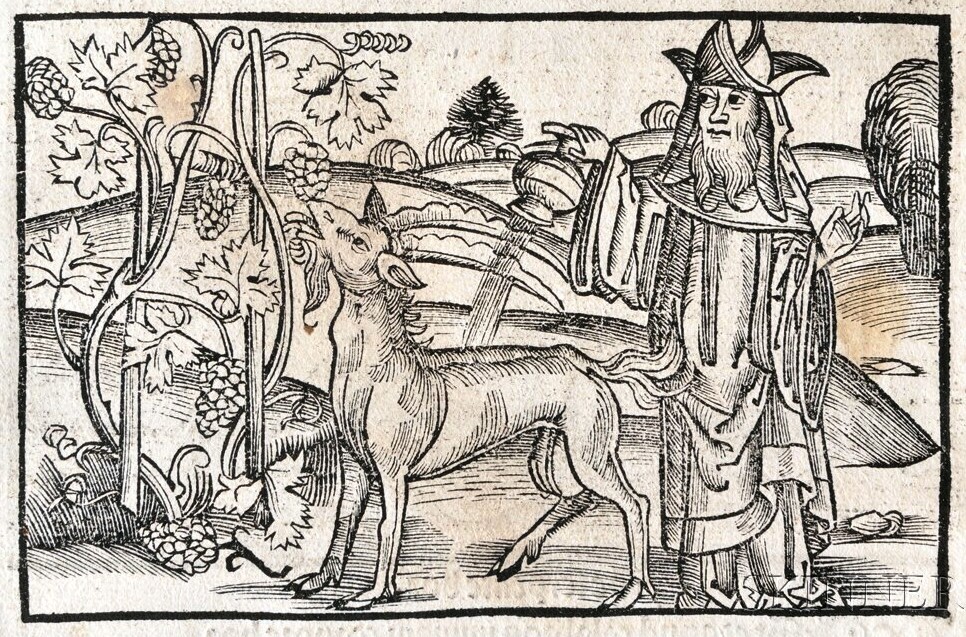The Goat And The Vine on:
[Wikipedia]
[Google]
[Amazon]
 The Goat and the Vine is counted as one of
The Goat and the Vine is counted as one of
''The story of Ahikar''
London 1898 but the goat or deer involved answers that, while this may happen in the future, for the present it needs to satisfy its hunger.
illustrations from books
{{Aesop Goat and the Vine Greek Anthology Fiction about goats
 The Goat and the Vine is counted as one of
The Goat and the Vine is counted as one of Aesop's Fables
Aesop's Fables, or the Aesopica, is a collection of fables credited to Aesop, a slave and storyteller believed to have lived in ancient Greece between 620 and 564 BCE. Of diverse origins, the stories associated with his name have descended to ...
and is numbered 374 in the Perry Index
The Perry Index is a widely used index of "Aesop's Fables" or "Aesopica", the fables credited to Aesop, the storyteller who lived in ancient Greece between 620 and 560 BC. The index was created by Ben Edwin Perry, a professor of classics at the Un ...
. There is also a West Asian
Western Asia, West Asia, or Southwest Asia, is the westernmost subregion of the larger geographical region of Asia, as defined by some academics, UN bodies and other institutions. It is almost entirely a part of the Middle East, and includes An ...
variant.
The fable and its versions
When a goat starts eating a vine's leaves and shoots, the vine retorts that it will still have enough juice left to produce grapes, the wine from which will be poured over it when the goat is sacrificed. The earliest record of the fable is in an epigram byLeonidas of Tarentum Leonidas of Tarentum (; Doric Greek: ) was an epigrammatist and lyric poet. He lived in Italy in the third century B.C. at Tarentum, on the coast of Apulia (Magna Graecia). Over a hundred of his epigrams are present in the Greek Anthology compiled ...
, who lived in the area of southern Italy colonised by Greeks
The Greeks or Hellenes (; el, Έλληνες, ''Éllines'' ) are an ethnic group and nation indigenous to the Eastern Mediterranean and the Black Sea regions, namely Greece, Cyprus, Albania, Italy, Turkey, Egypt, and, to a lesser extent, oth ...
in the 3rd century BCE. Later Greek references come from Western Asia, including another epigram by Evenus of Ascalon containing simply the vine's retort and the prose collection of fables by Aphthonius of Antioch
Aphthonius of Antioch ( el, Ἀφθόνιος Ἀντιοχεὺς ὁ Σύρος) was a Greek sophist and rhetorician who lived in the second half of the 4th century CE. Life
No information about his personal life is available except for his fri ...
. Elsewhere in Europe it first appeared in Latin fable collections from German language areas, including Sebastian Brant
Sebastian Brant (also Brandt) (1458 – 10 May 1521) was a German humanist and satirist. He is best known for his satire '' Das Narrenschiff'' (''The Ship of Fools'').
Biography
Brant was born in Strasbourg to an innkeeper but eventually enter ...
's ''Esopi Appologi sive Mythologi'' (1501) and the 150 poems based on fables by Pantaleon Candidus Pantaleon Candidus was a theologian of the Reformed Church and a Neo-Latin author. He was born on 7 October 1540 in Ybbs an der Donau and died on 3 February 1608 in Zweibrücken.
Life and works
Pantaleon Weiss was born the 14th child of a landown ...
(1604). The tale only began to appear in English fable collections in the 19th century.
In ancient times there was an alternative version of the fable that appeared in various recensions of the story of Ahiqar
The ''Story of Aḥiqar'', also known as the ''Words of Aḥiqar'', is a story first attested in Imperial Aramaic from the 5th century BCE on papyri from Elephantine, Egypt, that circulated widely in the Middle and the Near East.Christa Mül ...
from the first century CE. In the Arabic version, a gazelle nibbles a madder
''Rubia'' is the type genus of the Rubiaceae family of flowering plants, which also contains coffee. It contains around 80 species of perennial scrambling or climbing herbs and subshrubs native to the Old World. The genus and its best-known spe ...
plant, which threatens that it will be used to tan the goat's hide when the animal is killed and skinned. Madder or other tanning agents make a similar threat in the Syriac, Armenian and Slavonic versions of the story,London 1898 but the goat or deer involved answers that, while this may happen in the future, for the present it needs to satisfy its hunger.
References
External links
19–20th centurillustrations from books
{{Aesop Goat and the Vine Greek Anthology Fiction about goats